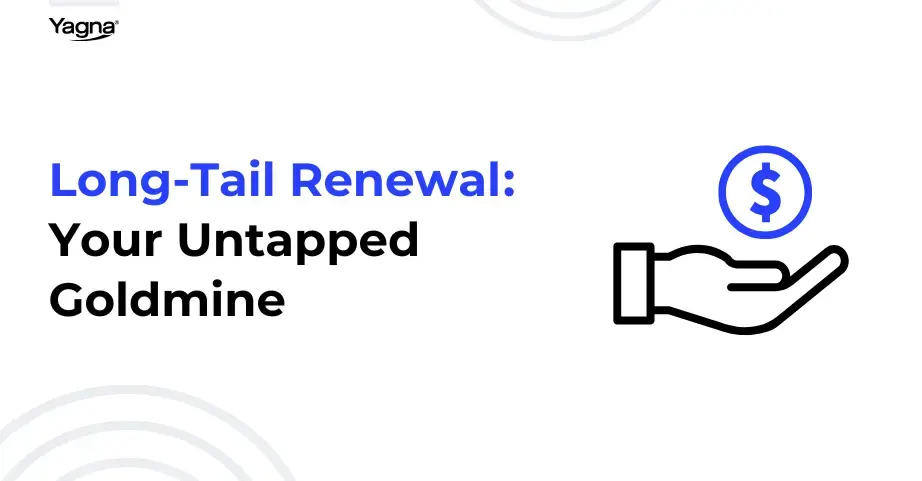
Long-Tail Renewal: Your Untapped Goldmine
In the latest installment of Yagna’s webinar series, the focus shifted to a powerful yet often overlooked asset in channel ecosystems:
Long-Tail Renewals
This webinar featured a special guest, Jay McBain, Chief Analyst and channel expert, who brought a wealth of insights as the chief analyst at Canalys.
He kicked off the discussion by exploring the distinction between “Channel” and “Ecosystem.”
While the channel refers to traditional distribution methods—originating in the 1980s with IBM’s initial PC distribution model—today’s ecosystem has evolved into a complex network of transactional and non-transactional partner interactions.
According to McBain, nearly 73% of the tech industry operates through indirect channels, so it is essential to look beyond pure sales transactions to the broader ecosystem that drives partner-assisted customer journeys.
In addition, McBain highlighted a growing trend: 96% of tech industry engagements are partner-assisted, meaning that customer influence now involves multiple partners and complex digital footprints.
He explained that this evolution is redefining traditional channel models, pushing vendors to consider broader ecosystems rather than linear partner pipelines.

Automation: A Necessity for Long-Tail Success
Automation emerged as a key theme during the discussion. Rachel Brinley, Senior Analyst at Canalys, recently published an article emphasizing the critical role of onboarding and digital tools in the shift to “as-a-service” and Annual Recurring Revenue (ARR) models.
With the traditional point-of-sale structure fading, vendors are challenged to onboard, educate, and maintain loyalty among a more extensive network of partners than ever before without significantly expanding resources.
For long-tail partners, automation is no longer optional. McBain underscored the importance of automating workflows, business logic, and processes to make partnerships scalable and reliable. Through tools like Yagna’s automation solutions, vendors can streamline non-transactional partner activities that play a crucial role in customer retention and lifetime value. This automated approach not only eases program management but also ensures scalability, enabling companies to maintain close relationships even with their extensive long-tail partners.
The AI Shift: Rethinking Channel and Ecosystem Strategies
A lively discussion on the role of AI followed, with McBain addressing both the hype and the reality of AI in the channel ecosystem. Although AI has yet to revolutionize the industry, McBain emphasized that its potential is undeniable, with channels rapidly embracing early AI-driven solutions that streamline data collection and partner profiling. For example, AI can be leveraged to assess the health of long-tail partners by checking digital activity, verifying business status, and even evaluating engagement history.
Still, McBain encouraged vendors not to stop with the long-tail but to apply AI insights across all partner segments. This data-driven approach empowers vendors to refine their strategies, tailoring support to active partners and reallocating resources to optimize revenue streams.
Navigating Policies and Maintaining Loyalty
One of the practical challenges raised by Jay McBain involved adapting internal policies to reflect the modern channel environment. As technology and partner needs evolve, incumbency—often based on outdated criteria—may require re-evaluation. Policies that once rewarded loyal partners based on past performance now need updating to account for new realities in the long-tail landscape. Vendors should consider implementing metrics that reflect both partner viability and engagement to ensure long-standing relationships continue to deliver value on both sides.
Looking Forward: Building the Future of Partner Ecosystems
Navigating the modern channel ecosystem requires embracing automation, AI, and adaptable policies. By proactively managing long-tail partnerships and leveraging technology, vendors can open untapped revenue streams, fostering a more resilient and vibrant partner network. As McBain emphasized, those who embrace these innovations will be well-positioned to lead in the next evolution of the channel ecosystem.
This conversation touches on the challenge of managing long-tail partners effectively, especially in relation to capacity, resources, and automation. The speaker highlights the historical push to cut the long tail due to perceived low revenue and resource limitations, recounting experiences at companies like HP and IBM where the long tail was deemed expendable, only to reveal later its hidden value in list-price margins and consistent revenue streams.
Businesses can make these partnerships more cost-effective by automating low-cost transactions for long-tail partners.
For instance, automating more minor sales at list price without extensive human intervention preserves profitability and could even scale these relationships. However, automation alone isn’t enough; vendors need tailored engagement strategies that reflect the unique goals and business needs of each long-tail partner.
As noted, merely considering these partners as resellers can be limiting; instead, aligning with their core business interests fosters better partnerships.
Buy or Build
The speaker emphasizes that while many companies try to build these capabilities in-house, it often falls short due to lack of specialized focus. Vendors regularly attempt to cobble together features within their existing CRM systems, only to find that dedicated tools in the market are more effective and scalable in the long run. This shift from “build” to “buy” reflects an understanding that industry-standard tools provide greater value, are continually updated, and spread costs across multiple clients.
Lastly, they point out that while net-new logos are costly to acquire, long-tail partners can be viewed as a source of new growth if approached with fresh strategies. In sum, the key to maximizing the long tail lies in data-driven insights, automation to reduce costs, and a targeted, relationship-oriented approach.
They’ve taken the reins by combining art with science to create measurable, reliable, and repeatable results. That’s where channel management is heading—toward a system that’s scientific, precise, and driven by data. If you’re in partnerships, it’s time to start thinking operationally. We’re not just working on relationship building; we’re optimizing an entire ecosystem that, in a few years, will be analyzed down to the last detail, just like sales and marketing. The leaders in this space will be the ones who can leverage technology and data to streamline and grow their long-tail partnerships in a way that’s repeatable and accountable.